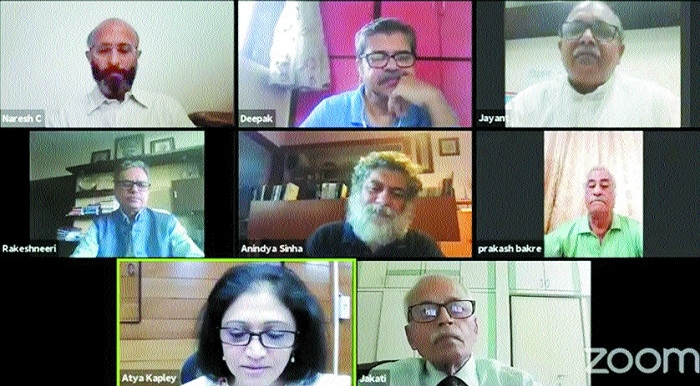‘Tap traditional knowledge for biodiversity conservation’
| Date :06-Jun-2020 |

The panelists in on-line panel discussion organised by NEERI and Vijnana Bharati to mark World Environment Day.
Staff Reporter ;
CSIR-National Environmental Engineering Research Institute (CSIR-NEERI) and Vijnana Bharati (VIBHA) jointly organised various programmes to mark World Environment Day. It organised a panel discussion on ‘Urban Biodiversity and Biodiversity Preservation for Integrating Society’. Dr Deepak Apte, Director, Bombay Natural History Society (BNHS); Prof Anindya Sinha, National Institute of Advanced Studies (NIAS); Prof P P Bakre, former Professor, Rajasthan University; Jayant Sahasrabuddhe, National Organising Secretary, Vijnana Bharati; and Dr R D Jakati, former Director, Indira Gandhi National Forest Academy, took part as expert panelists in the online panel discussion.
In his keynote address, Prof Sinha highlighted the challenges to biodiversity conservation in north-eastern India. Of 36 global biodiversity hotspots across the world, four were in India including the Indian Himalayan region, north-eastern India, Nicobar group of islands, and Western Ghats. Expressing concern over the Eastern Himalayas, he said that due to human interference and climate change biodiversity in Arunachal Pradesh is gradually diminishing.
The state of biodiversity and its significance were comparatively poorly known to conservationists in north-eastern India due to low priority in research, inaccessibility, and remoteness. However, one of his biological expeditions in this biodiversity hotspot resulted in the discovery of Arunachal macaque ‘Macaca munzala’ in the high altitudes of western Arunachal Pradesh, a primate new to science. He said. “We need to think about welfare of local people as human welfare is linked to preservation of biodiversity in a variety of ways. We also need to preserve our traditional knowledge to conserve biodiversity of north-eastern India.” He advocated participation of local community and re-introduction of critically endangered species, as was done in the case of pigmy hog-a mammal found in the north-eastern region. Dr Apte said that while focusing on tiger, other species were neglected. “It is time we move from species-specific conservation projects to landscape conservation to sustain all species,” he said.
Prof Bhakre said that the feathers of birds might provide clues to air pollution. Artificial lighting is threatening urban biodiversity and suitable species need to be selected for plantation drive to conserve urban biodiversity, he cautioned. Sahasrabuddhe emphasised upon the need to elicit interest and motivation among people, especially children, to act in favour of biodiversity conservation. Dr Jakati expressed concern over the forest cover data as it did not indicate biodiversity of the region and thus not satisfy sustainability. Biodiversity surveys need to be done periodically in various ecosystems, he added. Dr Atya Kapley, Senior Principal Scientist & Head, DRC, CSIR-NEERI, moderated the panel discussion.